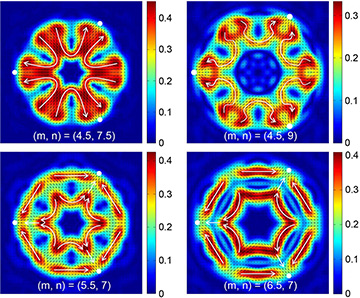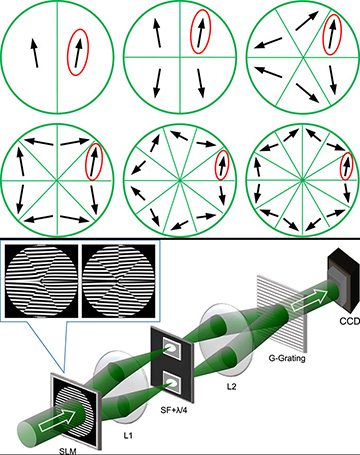Researchers in China have developed an approach for creating “kaleidoscope-structured vector optical fields” (KS–VOFs) in which the mirror symmetry of polarization can be arbitrarily changed. The direction of transverse energy flow in these fields (white and black arrows) can be shaped to create tentacle- or wrench-like features (upper left and right) that the research team believes could be useful in some optical trapping applications. [Image: Yue Pan/Qufu Normal University] [Enlarge image]
A team of researchers in China—drawing inspiration from the kaleidoscope, a toy familiar to generations of novelty-shop visitors—has developed a new technique for tweaking and engineering the mirror symmetry of polarization in structured optical fields (APL Photon., doi: 10.1063/1.5117269). The researchers believe that the adjustable symmetries and geometries of these polarization states, which the team has dubbed kaleidoscope-structured vector optical fields (KS–VOFs), offer an “additional degree of freedom” that could find use in applications in optical machining, trapping, photodetection and microscopy.
Toward a new control knob
Vector optical fields (VOFs) including spatially varying polarization have already been extensively studied by the optical community. Further, it’s well known that the polarization states of these fields generally include some sort of mirror symmetry. What’s been lacking, according to the authors of the new study—including first author Yue Pan of Qufu Normal University and team leader and OSA Life Member Hui-Tian Wang of Nanjing University—has been a way to arbitrarily create and tune these symmetries in VOFs. Finding such a method would open up a new control knob for shaping fields for a variety of optical tools.
To figure out a way to control such mirror symmetries, the team looked to the example a simple and familiar toy that specializes in generating them. The kaleidoscope, the researchers noted, creates its multiple, radially symmetric images via two angled mirrors, with the number of images created depending on the angle between the mirrors. The team wondered if an analogous parameter could be piped into a controllable element, such as a spatial light modulator (SLM), to control the mirror symmetry of polarization states in a structured light field.
Doing the math, testing the system
Top: Polarization states of KS–VOFs for values of s ranging from 1 (upper left) to 6 (lower right). Bottom: Experimental setups for generating KS–VOFs from an initial cylindrical VOF. The inset shows two typical grating patterns on the SLM that generate KS–VOFs. [Image: Y. Pan et al., APL Photon., doi: 10.1063/1.5117269 (2019); CC–BY 4.0] [Enlarge image]
The researchers led by Pan and Wang began by defining such a parameter, s—an integer that captures the number of mirror-symmetric axes in a KS–VOF created from an initial, locally linearly polarized cylindrical VOF. They then showed how that parameter can be controlled with the addition of a second, space-variant phase of light added to the initial cylindrical field. Hence, by loading an additional phase onto an SLM in an optical chain, the team reasoned, it should be able to generate, at will, KS–VOFs with a specific value of s.
To test the system out, the team put together a common-path interferometric setup including an SLM (with a transmission function that varied with the space-variant phase); lenses, filters and quarter-wave plates to handle the two orders diffracted from the SLM; and a Ronchi phase grating to put the orders back together again in a single light field with the desired mirror symmetry. The team found that the mirror symmetry of polarization in the output light in this experimental setup did indeed vary in good agreement with numerical simulations.
Tentacles and wrenches
The team also did a deep dive, both numerically and experimentally, into how changing the mirror symmetry using its system could be used to tweak the focal intensity patterns, spin angular momentum (SAM) density, and transverse energy flow of the resulting light fields. The investigation revealed a number of light fields that could prove intriguing for specific applications, according to the authors.
One such field, for example, was a tightly focused configuration with a subwavelength, flattop sharp line that the team believes “can be used in lithography and optical storage.” Another featured a controllable transverse energy flow distributed in “tentacles” or “spanners” (wrenches) that the researchers believe could create opportunities in optical trapping and manipulation of small particles (see opening image, above). The team also sees opportunities to use the system’s capability for redistributing SAM density as an adjustable parameter in optical switching, and for applications in polarization-sensitive photodetectors and microscopy.


